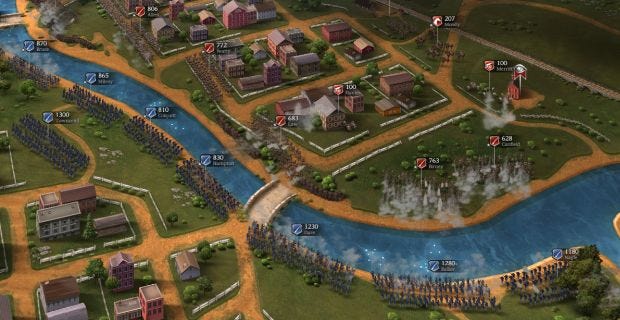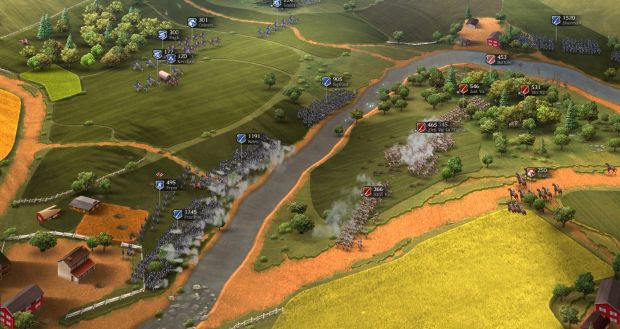Premature Evaluation - Ultimate General: Civil War
Rousseau, you yellow dog!
Every week we dispatch Brendan onto the battlefields of early access alongside a battalion of eager troops. This week, he attempts to become a renowned tactician for the Union in Ultimate General: Civil War [official site].
I don’t know much about this period of American history, except that Abraham Lincoln was the goodie and Clint Eastwood won the war by blowing up a bridge with a Mexican friend. But I do like a good strategy game, the practice of shunting little toy soldiers about and watching as long bits of geometry engulf other, smaller bits of geometry. So come with me if you want to see what it's like to "draw" a war.
Although the same developer has already seen some praise with Ultimate General: Gettysburg, the series is new to me. I won’t be able to tell fans and history gluttons what is new or what subtle and accurate nods to the era it houses. I’ll leave that to Tim. But I can give you a general idea. Ha ha ha. A general idea.
To start with the ins and outs of battle. Your troops are forged into Total War style divisions, and although they are represented as sprites on a mostly-static background it somehow manages to look handsome. You can’t zoom in so far that you can see what’s happening between clashing soldiers, but this works in the game’s favour, keeping you from being distracted and noticing the tiny gaps in any sprite’s animation.
Orders and movement are simple. Left-click a unit and drag to draw a course – a blue or red line that can swoop, slalom, curve or loop as much as you like. Alternatively, right-clicking and holding will let you place the unit facing a particular direction. The whole idea, as ever, is to get your warhouse in order, line up your troops and watch your flanks. A flanked unit can be torn to shreds by an opposing infantry unit, harassed and maligned by opportunistic skirmisher troops or wrecked by distant cannon fire. You may not lose everyone in a flanked unit in one fell blow, as in faster-paced strategy games, but they will quickly make the decision to fall back, taking all control away from you and forcing you to move your commanding officer to intercept them and boost their morale. Anything within this officer’s circle of influence will get a boost.
There are environmental things to grasp. Certain terrain gives you bonuses to other stats. You can hide skirmishers in woodlands for a big stealth bonus, or put your infantry men in a wheat field for a small boost to their cover. There are emplacements to garrison your men, depending on the map – farms, camps, dugouts. And crossing a river slows your men down to a stressful crawl, making them easy targets. This last hazard often has the effect of making both sides line up on either side of a river, each taking turns to shoot the other, like gentlemen, because neither side is brave enough to storm across the water and get heroically slaughtered.
It feels good to get your men into a position of strength, and worrying when you see unbeatable odds marching toward your haphazard defences, or an enemy calvary unit looping behind you to charge your vulnerable artillery division. One of the best missions I played involved being outnumbered 2 to 1 and attempting to scramble together a decent defence out of skirmishers, cannons and horsemen. It did not work.
But this was one of the game’s multi-part “grand battles” as part of an ongoing and personalised campaign. Each time I was overwhelmed, the script said: “and now you fall back”, opening up a new part of the map each time and forcing me to retreat the units as best as possible, often leaving whole companies behind in fortified positions just to buy the cannons and other slow units some time to escape. Eventually, we got back to a river landing, where reinforcements arrived and two gunboats pounded the attackers over two days of fighting. The confederacy stormed the battlements time and time again, always getting scared and running away, until finally the game decided I had earned a draw. Why the AI didn’t decide to charge me in an all-out assault, using every unit at once, I don’t know. If it had, I would have definitely lost. If there’s one thing I noticed about the battles it’s that the AI sometimes does not know its own strength. But this might be different on a higher difficulty.
As for this campaign mode, you can craft your army with limited resources as you go from battle to battle on a yellowed map of the US. At the start, it gives you the chance to create a commander with different specialisms and attributes. Pump up your logistics stat and you’ll have a higher supply of starting ammunition (your units can quickly run out of ammo, and need to be resupplied by a slow and vulnerable wagon unit – and this too can run out of supplies). And a higher politics stat will let you recruit more able-bodied men. I came out of West Point Academy with a higher training statistic than anything else, meaning I could recruit veteran fighters (rather than your default greenhorns) at a much cheaper price than normal.
As you fight, you gain skill points to dish out and increase stats as you please. But you also get reputation points and cash, which let you buy more divisions or new guns for your warchumps. You can also hire fresh officers. Like your general, these too gain bonuses after fights, increasing discipline, stamina, and other soldierly characteristics. Meaning your men are less keen to run away at the first sight of cross-looking rebel, and less prone to becoming exhausted and being unable to run.
All the components of a good strategy are there. It's handsomely-made, often difficult, and smugly satisfying in that tactical sort of way. At the same time, I wish some of the menus and mechanics were more understandable to a newcomer. The odd tutorial message box pops up and gives a very summary explanation of mechanics like cover or morale, offering links to a more detailed guide. But this being early access, the guide book has not been filled in, which leaves you wondering how the machinery and number crunching is done [Guess what! They just added this in-game guide in an update, scant moments before going to press]. It’s likely understandable to anyone whose stuck with the penultimate Ultimate General, but for me there still seemed to be a lot unsaid, a lot of clever things happening inside the simulation that I couldn’t take into account.
As a result, you can probably enjoy Civil War on two levels: the first, as a devotee of the genre, the history and the series. The second, as an experimenting newcomer. Even if you don’t care about the statistical difference between a Colt Model 1855 and a Springfield M1855, there’s still plenty of hurrahs to be had fighting for your life against overwhelming odds in the more-scripted scenarios. I repeatedly found myself swearing at the screen, telling that sniveling coward colonel Rousseau to “get the fuck back to the line”, or ordering my heroic Brigadier General to waltz up and down encouraging the men, while also taking part in absolutely none of the fighting.
It’s likely to make a lot of people very happy. From what I understand, it expands a lot on what the previous entry did and offers much more variety in terms of locations and historical battles. The previous game focused on one important battle, but this covers four years of WAR and lets you approach it with a sense of military continuity. Yet, while I like the battling, and the way you can draw or lose a fight and just keep on going (a campaign win gains reputation and cash, a loss reduces it), I still sometimes feel lost while playing it. What's going on underneath it all? In short, if you already know what the deal is: you have a treat. But if you don’t, you may have to embrace some unknowns [or learn things] to have the best possible time.
Ultimate General: Civil War is available on Steam for £22.99/$29.99. These impressions were based on version 0.66.

















